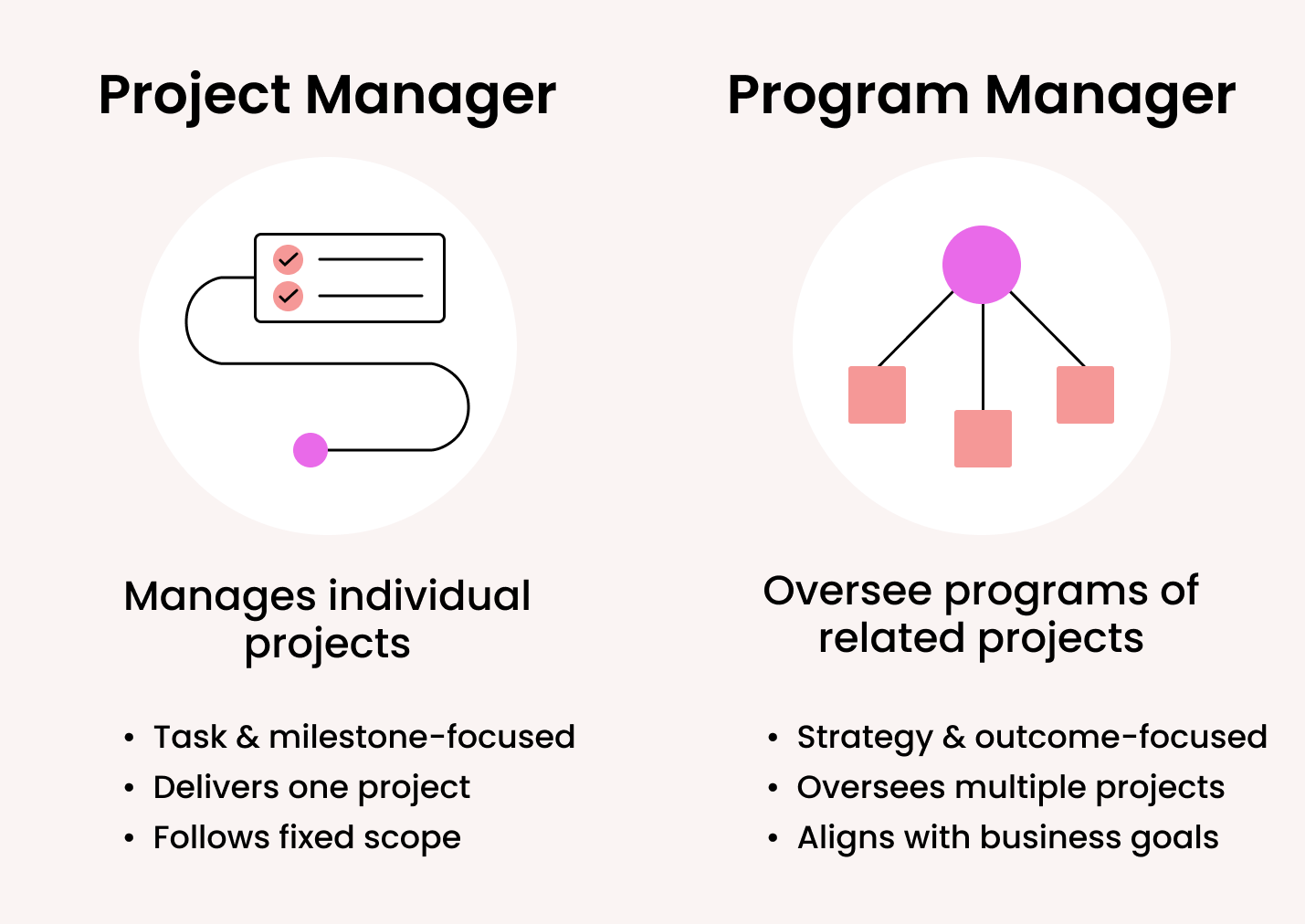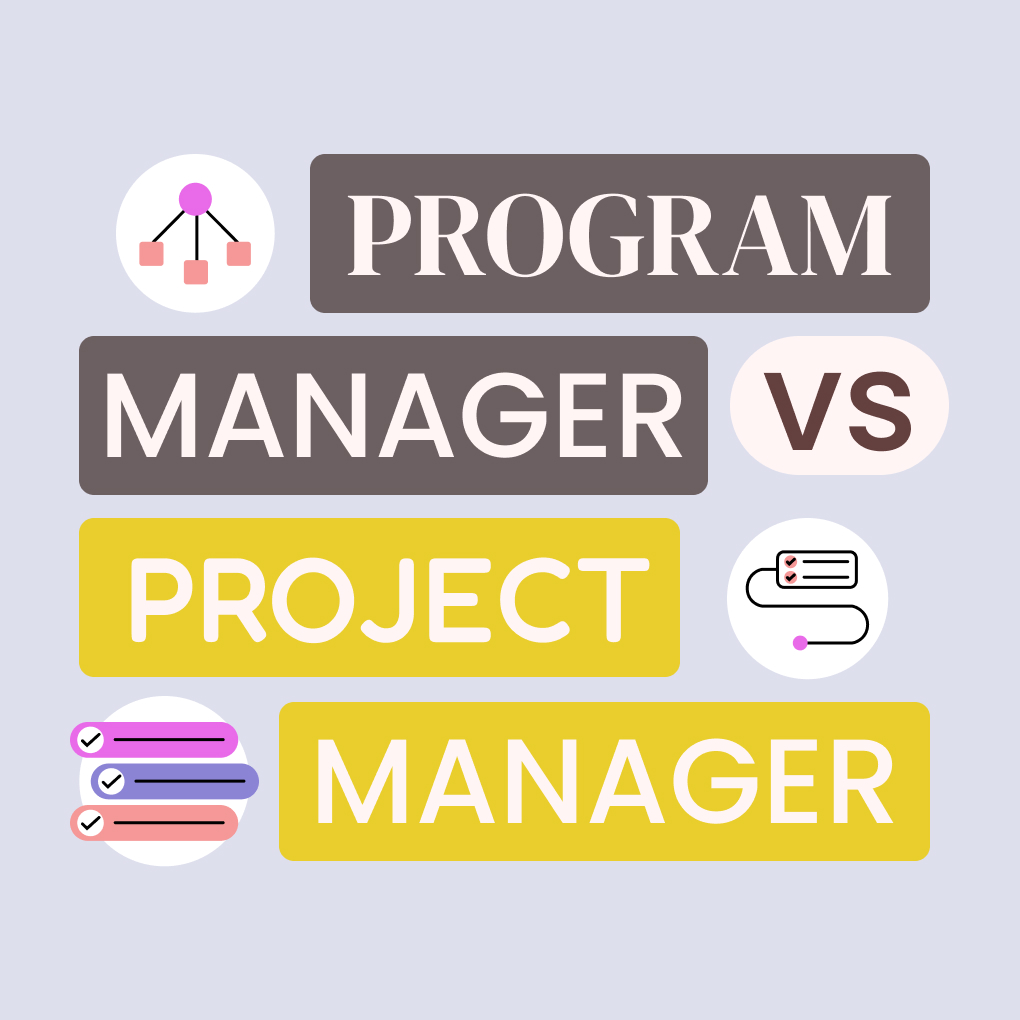The terms “project” and “program,” along with their management roles, are often confused, but using them interchangeably can result in strategic errors and wasted resources. Recognizing the differences between project managers and program managers is essential for clarity, effective resource use, and successful execution of initiatives within organizations.
This article is a detailed guide for professionals and HR teams to understand the differences between program and project structures, including management roles and how to choose the best approach for their needs.
What’s the Difference Between a Project and a Program?
At first glance, projects and programs might seem similar – both involve tasks, timelines, and goals. However, their scope, duration, and strategic alignment set them fundamentally apart. Understanding this distinction is the first step in appreciating the difference between program and project management.
Definition of a Project
A project is a temporary endeavor undertaken to create a unique product, service, or result. Key characteristics include:
- Defined Scope: Projects have specific objectives, deliverables, and boundaries. What needs to be achieved is clearly outlined.
- Temporary Nature: Projects have a definite start and end date. They are not ongoing operations.
- Unique Outcome: The goal is to produce something specific and distinct, whether it’s a new software feature, a marketing campaign, a building, or a research report.
- Resource Constraints: Projects operate within defined constraints of time, budget, and resources (personnel, equipment, etc.).
Think of a project as a focused effort aimed at delivering a particular output. Success is typically measured by completing the project on time, within budget, and according to the specified requirements. The focus is often tactical – getting a specific job done efficiently. This is the core of project vs project management discussions.
Definition of a Program
A program, on the other hand, is a group of related projects, subprograms, and program activities managed in a coordinated way to obtain benefits not available from managing them individually. Key characteristics include:
- Strategic Alignment: Programs are directly linked to achieving broader organizational goals and strategic objectives. They deliver outcomes and benefits, not just outputs.
- Longer Duration: Programs typically span a longer timeframe than individual projects, sometimes lasting years. Their end date might be less defined initially and more tied to the achievement of strategic benefits.
- Interrelated Projects: The constituent projects within a program are interconnected. Their combined success contributes to the overall program goals. Managing these interdependencies is key.
- Benefit-Oriented: Success is measured by the realization of intended benefits and the contribution to strategic goals, rather than just the completion of individual projects.
- Greater Complexity: Programs involve managing multiple project streams, cross-project dependencies, resource conflicts, and a wider range of stakeholders.
A program provides a framework for managing related efforts to achieve significant organizational change or strategic advantage. It’s about the bigger picture and long-term value.
Key Structural and Strategic Differences
| Feature | Project | Program |
| Focus | Specific outputs, deliverables | Strategic benefits, outcomes |
| Scope | Narrowly defined, specific objectives | Broad, aligned with organizational strategy, evolves |
| Timeline | Finite, clear start/end dates | Longer-term, potentially variable end date based on benefits |
| Management | Managing tasks, resources, risks for one goal | Coordinating multiple projects, managing interdependencies |
| Success Metric | On-time, on-budget, scope completion | Realization of strategic benefits, overall value delivered |
| Change | Managed tightly to protect scope | Expected and adapted to achieve strategic goals |
| Complexity | Lower (relative to programs) | Higher, managing multiple interconnected components |
Understanding this program vs project difference is fundamental. A project delivers something; a program delivers value through coordinated efforts.
Examples of Project vs. Program
Let’s illustrate the program project difference with examples:
- Project: Designing and launching a new company website.
- Goal: Deliver a functional, user-friendly website by Q3.
- Tasks: Wireframing, design mockups, development, content creation, testing, launch.
- Outcome: A new website goes live.
- Program: Implementing a company-wide digital transformation initiative.
- Goal: Enhance customer experience, improve operational efficiency, and increase market share through digital technologies over three years.
- Constituent Projects:
- 1. New website launch (as above).
- 2. Developing a mobile application.
- 3. Implementing a new CRM system.
- 4. Migrating data to the cloud.
- 5. Training staff on new digital tools.
- 6. Launching targeted digital marketing campaigns.
- Outcome: A transformed business model leveraging digital capabilities, leading to increased revenue and customer satisfaction.
In this example, launching the website is a single project with a defined output. The digital transformation is a program coordinating multiple projects to achieve broader, strategic benefits.
Project Management vs. Program Management
Building on the difference between projects and programs, we can now explore the difference between program and project management. While both disciplines involve planning, executing, and monitoring, their focus, scope, and approach differ significantly.
Scope and Complexity
- Project Management: Deals with the scope of a single project. The complexity lies in managing the tasks, resources, risks, and budget required to achieve specific, defined deliverables. The project manager works to prevent scope creep and deliver exactly what was agreed upon.
- Program Management: Manages the scope of a collection of related projects. The complexity is much higher, involving the coordination of multiple project scopes, managing interdependencies between them, resolving resource conflicts across projects, and adapting to changes that affect the overall program goals. Program managers embrace scope evolution if it serves the strategic objectives. This highlights a key aspect of program vs project management.
Focus: Tactical vs. Strategic
- Project Management: Primarily tactical. The goal is to carry out the project plan efficiently and effectively, ensuring that we deliver the expected results on time and within budget. It’s about doing things right.
- Program Management: Primarily strategic. The goal is to make sure that all projects work together to achieve the desired business benefits and support the organization’s strategic goals. This includes deciding which projects to prioritize, adjust, or even end based on how much they add to the overall value of the program. It’s about doing the right things.
Timeline and Deliverables
- Project Management: Oversees shorter timelines with clear milestones and deliverables. Success depends on meeting these deadlines and delivering the expected results.
- Program Management: Manages longer, often evolving timelines. Deliverables are often outcomes or benefits realized over time, rather than just tangible outputs. Success is measured by the achievement of these strategic benefits, which might occur incrementally as projects within the program are completed.
Interdependency of Tasks vs. Projects
- Project Management: Focuses on managing the dependencies between tasks within a single project. Tools like Gantt charts are used to sequence activities correctly.
- Program Management: Focuses on managing the dependencies between multiple projects. The output of one project might be the input for another, or multiple projects might compete for the same resources. The program manager must orchestrate these interconnections to ensure smooth progress towards the overall program goals.
Risk and Stakeholder Management
- Project Management: Identifies and mitigates risks that could impact the project’s timeline, budget, or deliverables. Stakeholder management typically involves the project team, sponsors, and key end-users directly related to the project’s output.
- Program Management: Takes a broader view of risk, considering threats and opportunities that could impact the overall program’s strategic benefits. Stakeholder management is more complex, often involving senior executives, multiple department heads, external partners, and potentially customers, requiring sophisticated communication and negotiation skills to align diverse interests towards the program’s vision.
Program Manager vs. Project Manager: Role Comparison

Given the differences between projects and programs, and their respective management disciplines, it follows that the roles of the Project Manager and Program Manager are distinct. Understanding the project manager program manager difference is vital for assigning the right leadership to initiatives.
Responsibilities and Goals
- Project Manager:
- Responsibilities: Define project scope, create a detailed work plan, manage project budget and resources, track progress, manage risks and issues, lead the project team, communicate status updates, ensure deliverables meet quality standards, and formally close the project.
- Goals: Deliver the project’s specific output on time, within budget, and according to scope and quality requirements. Ensure team cohesion and stakeholder satisfaction for the project.
- Program Manager:
- Responsibilities: Define program vision and roadmap, align projects with strategic objectives, manage the overall program budget, coordinate and prioritize constituent projects, manage interdependencies and resource allocation across projects, oversee program-level risks and changes, manage relationships with senior stakeholders, ensure benefit realization, and communicate overall program health.
- Goals: Achieve the program’s strategic objectives and business benefits. Ensure the coordinated management of projects delivers more value than managing them separately. Provide strategic oversight and governance.
The core program manager vs project manager distinction lies here: the project manager delivers outputs; the program manager orchestrates projects to deliver strategic outcomes and benefits.
Required Skills and Qualifications
While there’s overlap, the emphasis differs:
- Project Manager Skills:
- Strong organizational skills
- Task management and scheduling
- Budgeting and cost control
- Risk identification and mitigation (project-level)
- Clear communication (team, immediate stakeholders)
- Problem-solving (tactical)
- Team leadership and motivation
- Proficiency in project management methodologies (Agile, Waterfall, etc.)
- Program Manager Skills:
- Strategic thinking and business acumen
- Financial management (program-level budgets, ROI)
- Advanced risk management (program-level, strategic)
- Stakeholder management and negotiation (senior level)
- Leadership and influence across multiple teams
- Change management
- Benefit realization management
- Strong understanding of organizational goals
- Ability to manage ambiguity and complexity
A programme project manager (using the UK spelling sometimes seen) requires a broader, more strategic skill set compared to a manager focused solely on a single project programme.
Tools Used
Both roles rely heavily on tools to manage their work effectively.
- Project Managers often use:
- Task management software (e.g., Asana, Trello, Jira for specific methodologies)
- Gantt chart tools (e.g., Microsoft Project)
- Spreadsheets for budgeting and tracking
- Communication tools (e.g., Slack, Microsoft Teams)
- Collaboration platforms
- Program Managers need tools that provide a higher-level view and facilitate coordination across projects:
- Portfolio management software
- Roadmapping tools
- Financial planning tools
- Advanced reporting and analytics dashboards
- Robust communication and collaboration platforms
Program and project managers benefit from platforms that support both detailed execution and strategic oversight. An integrated workspace like Morningmate caters to these distinct needs within a unified environment. Project managers can leverage its task management, feed-style updates, and specific tool integrations (Zoom, Google Drive) for efficient project delivery. Simultaneously, Program managers gain a consolidated view across projects, utilize the org-structured messenger for streamlined communication, track high-level progress, and employ AI features for reporting or subtask generation. This facilitates seamless collaboration and information flow between the tactical project level and strategic program leadership, making it valuable for managing both individual projects and coordinated programs.
How Program and Project Managers Work Together
In organizations running programs, project managers and program managers don’t operate in silos. Their collaboration is essential for success.
Collaboration Dynamics
Typically, project managers report functionally or administratively to a program manager for projects that fall within that program’s scope. The program manager provides strategic direction, context, and priorities, while the project manager focuses on the execution of their specific project within that framework. The program manager acts as an escalation point for issues the project manager cannot resolve and helps navigate cross-project dependencies or resource conflicts.
Communication Flow Between Roles
Effective communication is critical.
- Program Manager to Project Manager: Communicates overall program goals, strategic context, priorities, changes in direction, program-level risks, and decisions impacting the project. Provides guidance and support.
- Project Manager to Program Manager: Reports on project status (progress, budget, risks, issues), highlights dependencies on other projects, escalates critical issues, and provides data needed for program-level reporting and decision-making.
Regular meetings, shared dashboards (potentially within a tool like Morningmate), and clear reporting structures facilitate this flow.
Avoiding Role Confusion and Overlap
Clear definitions of roles and responsibilities are paramount. Organizations should establish:
- Distinct Job Descriptions: Clearly outlining the scope, authority, and responsibilities for each role.
- Defined Governance Structure: Clarifying reporting lines and decision-making authority within programs.
- Standardized Processes: Implementing consistent methods for project initiation, reporting, risk management, and change control across the program.
- Open Communication: Encouraging regular dialogue between program and project managers to address potential overlaps or ambiguities proactively.
When roles are clear, project managers can focus on delivery, and program managers can focus on strategic alignment and benefit realization, creating a synergistic relationship.
Which Role Does Your Organization Need?
Understanding the difference between project manager and program manager helps determine the right leadership structure for your initiatives.
Team Structure Considerations
- Small Teams/Simple Initiatives: If your organization primarily handles standalone initiatives with clear start/end dates and defined outputs, project managers are likely sufficient.
- Multiple Related Projects: If you have several interconnected projects working towards a larger, strategic goal, introducing a program manager to oversee these efforts can provide crucial coordination and strategic alignment.
- Large, Complex Organizations: Often require multiple layers, potentially including portfolio managers overseeing multiple programs, program managers leading strategic initiatives, and project managers executing the components.
Type of Work: Project-Based vs. Program-Oriented
- Project-Based Work: Characterized by discrete, temporary efforts to create specific deliverables (e.g., building a specific feature, running a single marketing campaign, organizing an event). This calls for project management.
- Program-Oriented Work: Involves long-term, strategic initiatives aimed at achieving significant business outcomes or transformations through a series of related projects (e.g., entering a new market, overhauling a product line, implementing a company-wide compliance framework). This necessitates program management.
When You Need Both
Most medium-to-large organizations undertaking significant change or managing multiple strategic initiatives will benefit from having both roles. You need project managers to ensure individual components are delivered efficiently and effectively. You need program managers to ensure these components work together harmoniously to achieve the overarching strategic objectives and deliver the intended business value. The program manager project manager relationship becomes key to executing strategy effectively.




